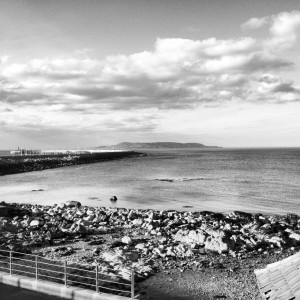I have always had a curious and, to put it plainly, odd relationship with large bodies of water. I loathe to be in them – my imagination runs wild and places Lovecraftian monstrosities just below the surface. I do not enjoy swimming at beaches, and mostly restrict my interaction with shore-water to whatever tendrils of liquid that make their way to my chair, momentarily distracting me from whatever weather-worn book I am reading.
As I stroll down the length of the walls that make up Dún Laoghaire’s harbor, I reflect on the juxtaposition that is my enjoyment of ocean-going vessels. I thoroughly enjoy riding on ships and boats, whether they’re river-running fishing tins or ocean-spanning cruise liners. One of my earliest hobbies was collecting miniature ships – my favorites were the majestic ships of the line from the 17th and 18th centuries, sails unfurled in imaginary winds. I’m sure they’re in a closet somewhere now, collecting dust.
I turn to look at the boats bobbing in the soft currents of the inner harbor. Some 200 years earlier, two ships that had departed from Dublin had smashed into the rocks near here. The British, still in control of Ireland at that time, realized the need for a permanent and protected harbor that could service Dublin. That plan developed into the harbor my feet carry me across now, old stone crunching beneath my heel. Plans had already existed at the time to create a harbor to service Dubin, but the loss of the Prince of Wales and the Rochdale, along with 400 souls between them, had put expediency into the lagging efforts.
Along with the increased interest from the English came other changes as well. Dún Laoghaire is as Irish a name as one could think for a little town near the ocean. The English, however, decided that Dún Laoghaire needed a proper and suitably English name, and so the town was christened ‘Kingstown’ when King Charles IV visited the new harbor in 1821.
Of course, when the Irish rebelled and won their independence from the English, they quickly began dismantling the signs and fixtures of their colonial rule, and the names of streets and towns were soon switched from their English designations to their original Irish names, and so Dún Laoghaire (or Dunleary) existed again.
I stop at the end of the pier, the lighthouse to my right and the harbor laid out in front of me. There are no more great sailing ships, unfortunately – the harbour is now home to a posh yacht club, and the two piers encompass the anchored boats like embracing arms. Looking down into the murky water, my minds eye sees something slither just under the surface. I shudder, and some deep level of my subconscious notes that I’ll want fish and chips for dinner tonight as some sort of symbolic gesture of defiance. Regardless, I begin my walk back, the sun warm on my back and my lungs full of salty air.

